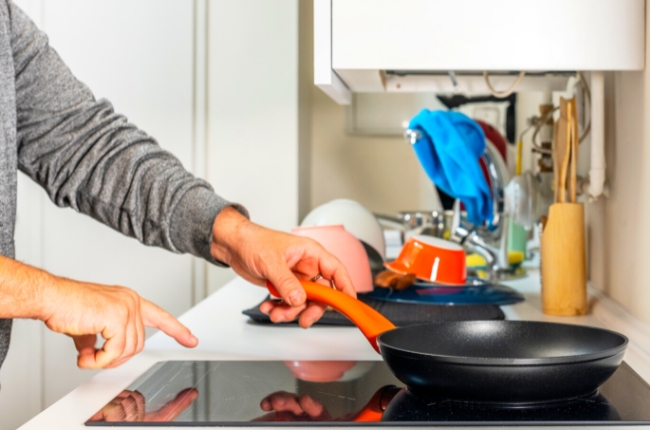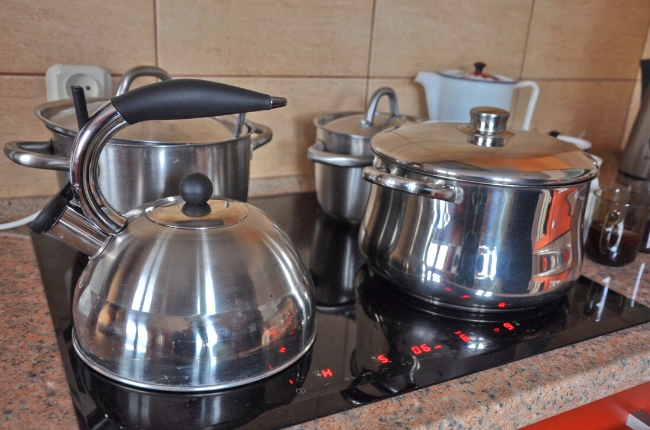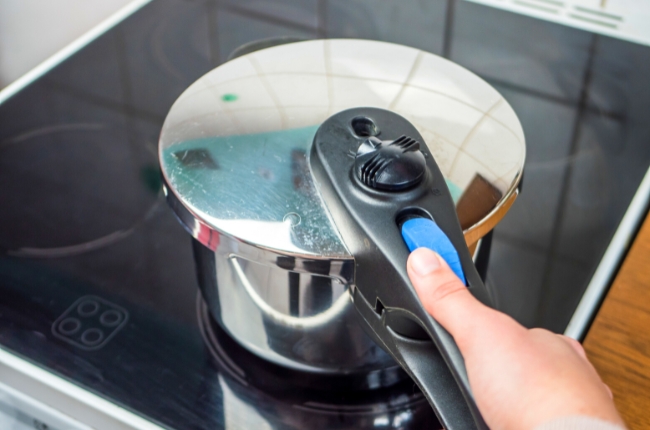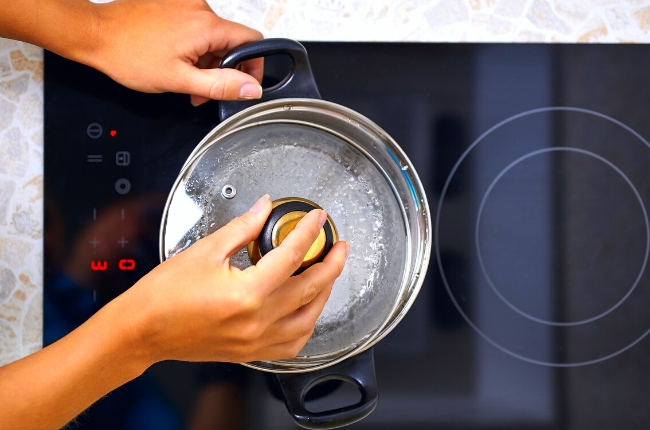With the whole holiday spirit slowly lurching her way to our fave city, it’s prime time to think about food preparation again.
And when it comes to efficiency and design, there’s nothing sleeker and more impressive than the induction cooktop currently in your kitchen. There is just one catch: your old pots.
Or is there some trickery you can do to get your old pots induction-friendly?
It’s time to solve your problems with some science and creativity! Today you’ll know how to trick an induction cooktop and save yourself money and worry.
Can you trick an induction cooktop?

Induction is new and technology-forward.
However, like anything new, it’s met with resistance from those who either find the good old flames too hard to leave or are confused about the required set-up and cookware.
What always works
Induction-compatible cookware has three main features: flat, smooth, and ferromagnetic.
You can also think of ferromagnetic cookware as those with a high percentage of iron in their material.
The science of induction relies on electromagnetism.
When you turn the power on, an alternating current passes through the metal coil underneath; this produces a fluctuating magnetic field that excites the iron atoms in your cookware. And once excited, they release energy in the form of heat.
Voila! Your pan just heated itself!
Cast iron cookware, like most dutch ovens, is the perfect example.
There’s a sufficient amount of iron to work with the induction cooktop. Enamelware or enameled cast iron also fits the criteria well. You can also look for graniteware (actually made of steel) and carbon steel cookware.
What might work
Stainless steel is a common cookware nowadays. It’s simple but highly efficient. However, not all types of stainless steel cookware work for your induction!
If you need to check the compatibility of your stainless steel, try to stick a magnet at the bottom of your cookware. If it sticks well, you can use it for your induction cooktop.
Aluminum, copper, and ceramic DO NOT work.
There is multi-ply clad cookware that may suit your induction. These have iron or magnetic stainless steel cores bonded to other materials like aluminum or copper to retain each composition’s advantages.
The importance of sufficient iron can’t be understated. Before you hurry and buy a new set of cookware that can break the bank, there’s one more thing you must know about your induction.
Burner zones are picky.
So far, you know they only work with compatible materials like cast iron. However, you must also be aware that burner zones only detect pans with flat-bottomed surfaces and correct diameters.
If an induction cooker cannot detect a pan even when it passes the magnet test and has a flat bottom, the pan or pot may be too small or too big for the burner zone.
Pro tip: Ensure that the pan sits snugly at the center of the zone. And if you plan on getting new cookware to complement your induction, measure your burner zones first or read the manual before shopping!
The dimension of your pan must be an inch bigger or smaller than the burner zone (indicated with a circle). Any size lesser or more may not be detectable.
How do I make my cookware induction compatible?

Tricking your cooktop needs creativity.
You must fool your induction into believing that you have the flat-bottomed, smooth, and compatible material it likes. And the good news is, the solution is already out there!
Skim the following for quick tips on using non-induction cookware with your induction cooktop.
1. Interface disc
An interface or converter disc is a round stainless steel plate with a handle. The metal plate acts as your DIY burner.
Since the plate is stainless steel and has iron, it will heat up via induction. The heat transfers to the non-induction cookware via direct heat transfer or conduction.
Pretty neat, right?
Although it technically defeats the purpose of induction, this method will save you a trip to the cookware section.
Of course, there are certain disadvantages to it.
For one, if you have a small pan in a large burner zone, you already use more power than necessary. Large burner zones have higher power requirements.
Furthermore, using a converter disk with non-induction cookware will lessen efficiency. Why?
Air is a bad conductor. The pockets of air between the disk and the pan slow down heat transfer. Heat will dissipate on the ceramic glass below, the kitchen air, and the pan.
Simply put, you don’t get 100% heat transfer, and you might need more time to cook or boil water.
Tip: To maximize efficiency, find a converter disk made by a reputable brand. Although they may be pricier, they also ensure less heat gets lost in the process.
One solution you might find helpful in resolving the air problem is using thermal paste.
2. Computer Thermal Paste
This may seem unfamiliar to you if you have never built a PC or taken apart one.
A thermal paste is a silvery substance that fills the air gaps and aids heat transfer between the CPU and the cooler.
Similarly, you’d want to fill the air gaps between your cookware and interface disk.
Apply a thin layer of the paste at the bottom of the pan and place it carefully on the converter disk before using the disk + cookware contraption on the induction.
Scrape off and apply the paste again after you cook since it breaks down when subjected to high temperature.
3. Trays, netted steel, and large pots?
If you think putting thermal paste is already unorthodox, you are in for another shocker.
First, let’s look at using a tray as an alternative to an interface disk.
In theory, you can place a waiter’s tray; it excites and heats itself, then transfers the heat to the pan. This plan may work especially if you have a flat-bottomed pan or pot since this provides maximum contact to the tray.
The second suggestion comes from Youtube. They used a double-folded steel mesh to act as an interface disk.
In theory, this may prove okay. However, you should not take this idea lightly and nonchalantly try it.
This may result in irritating fumes from the mesh, buzzing sounds, and, worse, may be a possible fire hazard.
Lastly, if you have a large burner zone and want to heat your non-induction small pot on it, you may use an induction-compatible large pot and then place the small pot inside it.
A word of advice: Metals may bend at higher temperatures, so even if you started with flat-bottomed cookware, it may warp a bit and add to the heating inefficiency.
Remember that extreme power modes may destroy surface coatings and release toxic chemicals on the food you are cooking.
How do you make aluminum work on induction?
Aluminum is famous for its lightweight quality, heat conductivity, and diffusivity.
Its inexpensive price tag is also a big plus. And as you already know, aluminum doesn’t work with induction.
However, a magnetized base makes all the difference. If your aluminum pan has a bottom with magnetic properties, it will work fine on induction.
You can also buy tri-ply cookware. These are pans and pots with an inner layer of aluminum and an exterior of stainless steel.
Tri-ply aluminum cookware distributes heat quickly, a feature of stainless steel, and distributes the heat evenly, thanks to its aluminum core.
Another trick is to make use of an interface disk.
Again, it is not energy efficient. It may even defeat the benefits you get from having aluminum pans at all. But it is a better alternative than replacing all your pans!
Can we use normal steel utensils on induction?

You already know that stainless steel generally has excellent induction compatibility. It is durable, easy to clean, and requires minimal maintenance. If you prefer a less colorful look in your kitchen, stainless steel is the way to go.
When choosing stainless steel cookware for your induction, you must select a magnetic grade one. Those with high nickel content will block the magnetic field and will not heat properly. Stainless steel 432 and ferritic stainless steel are great choices to consider.
If your worry lies on the spoons and spatulas you can use while induction cooking, here’s the good part: you can use anything as long as it suits your vessel.
You only have to ensure that the cookware itself is induction-suitable.
Here’s a quick guide on your spoon and spatula use.
- Wooden and silicone — anything, including nonstick, glass, and porcelain.
- Metal — for uncoated metal and cast iron
- Plastic — for nonstick only
If you want to use stainless steel kitchen utensils, make sure they have a silicone handle so you avoid dealing with a hot spatula on your hand while cooking!

Leave a Reply